This vegan butternut squash risotto is creamy and full of flavour. Topped with aromatic crispy sage leaves, this comforting risotto is delicious using only plant-based ingredients.

This vegan risotto is creamy and rich, without the use of cheese or butter. The combination of butternut squash and fresh sage is perfect for autumn, but this risotto is great to enjoy any time of year.
Risotto gets its creamy texture from the way it’s cooked. Traditional Italian risotto requires constant stirring. As we’re just a tiny bit more lazy, for our taste it’s enough to stir and top up the liquid every few minutes. you’ll still get a nice and creamy texture.
The butternut squash is cooked to the point where it is soft, subtly sweet and so tender, it will practically fall apart on your tongue. For a bit of a crunch, we sprinkle on some toasted seeds. Although the risotto is tasty as it is, you’ll love it topped with crispy fried sage leaves that are really easy to prepare.
A classic risotto would also call for white wine for deglazing. However, a lot of wine actually isn’t vegan, although a lot of people aren’t aware of this. You can read up on why not all wine is vegan in this article from VeganFriendly.
Lucky for you, you can make amazing risotto without the use of wine and still have plenty of flavour! Let us show you how to make this tasty and creamy butternut squash risotto from nothing but plants...

Ingredient tips
Short grain white rice like arborio is typically used to make risotto and is what we recommend. But if you fancy using a different type of rice, check out the variations and substitutions section below!
Butternut squash - It’s best to peel it, although if the squash is still young and it’s skin soft, you might not need to. Half a small butternut squash or a quarter large squash, or 2 cups when cubed, is enough for 1 cup of uncooked rice.
Sage - It’s best to use fresh sage, especially for the crispy fried sage leaves and the infused oil. The best sage is always the one picked straight from your garden!

For plenty of aroma we include an onion, oregano, black pepper and both fresh garlic and garlic powder. The last two are a great combo, as the fresh and powdered versions each show a different side of the flavour that garlic has to offer.
We deglaze with soy sauce and lemon or lime juice as a replacement for white wine when making risotto. We don’t tend to have white wine on hand, so therefore rarely use it for cooking.
Of course, vegetable bouillon or stock is a must to achieve a full bodied, hearty risotto.
Finally, nutritional yeast, stirred in at the end, brings a ‘cheesy’ note to vegan risotto, and helps with the creamy texture as well.
As far as the oil is concerned, we use extra virgin olive oil to prepare the risotto. But for frying the sage leaves, we prefer a less dominant, neutral flavoured oil or a blend of refined and virgin olive oil.
For a bit of a crunch, we also toast some sunflower and pumpkin seeds to sprinkle on top, although this is optional.
Step by step
You can find the full recipe, with ingredient list and detailed instructions, in the recipe card at the end of the post. Here's a visual guide on how to make vegan butternut squash risotto.

Step 1 - Sauté the onion in olive oil until just translucent.
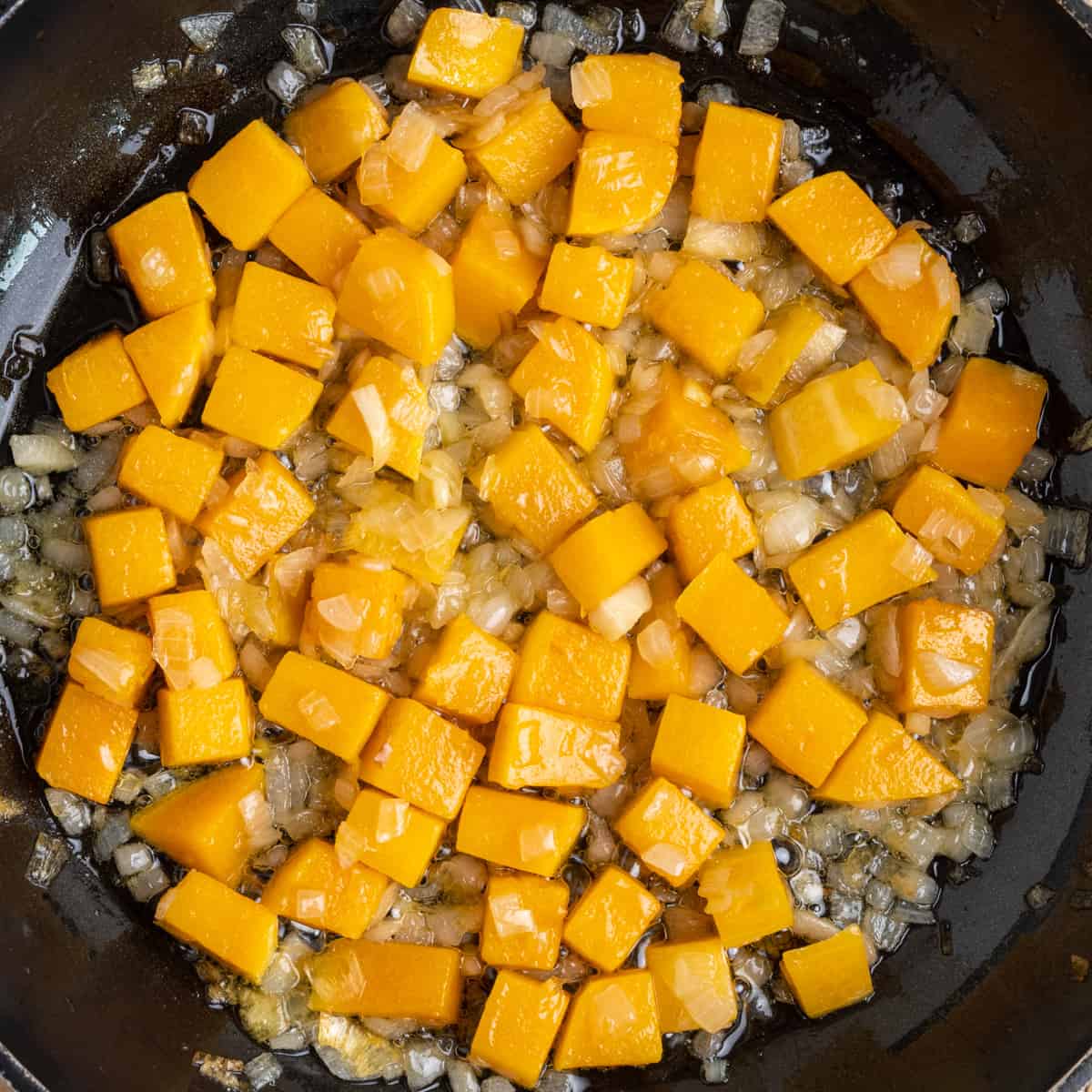
Step 2 - Add cubed butternut squash and continue to gently fry for 15 minutes.

Step 3 - Stir in fresh sage, garlic, oregano and pepper.

Step 4 - Add the risotto rice and stir to coat it in oil.

Step 5 - Briefly stir in bouillon powder and garlic powder, then deglaze with soy sauce, lemon juice and some water.

Step 6 - Add boiling hot water to cover the rice and squash in liquid.

Step 7 - Simmer with the lid on for 20 - 25 minutes, stirring and topping up with more boiling water every few minutes.

Step 8 - When the rice is al dente, stir in the nutritional yeast.

Step 9 - Toast the sunflower and pumpkin seeds.
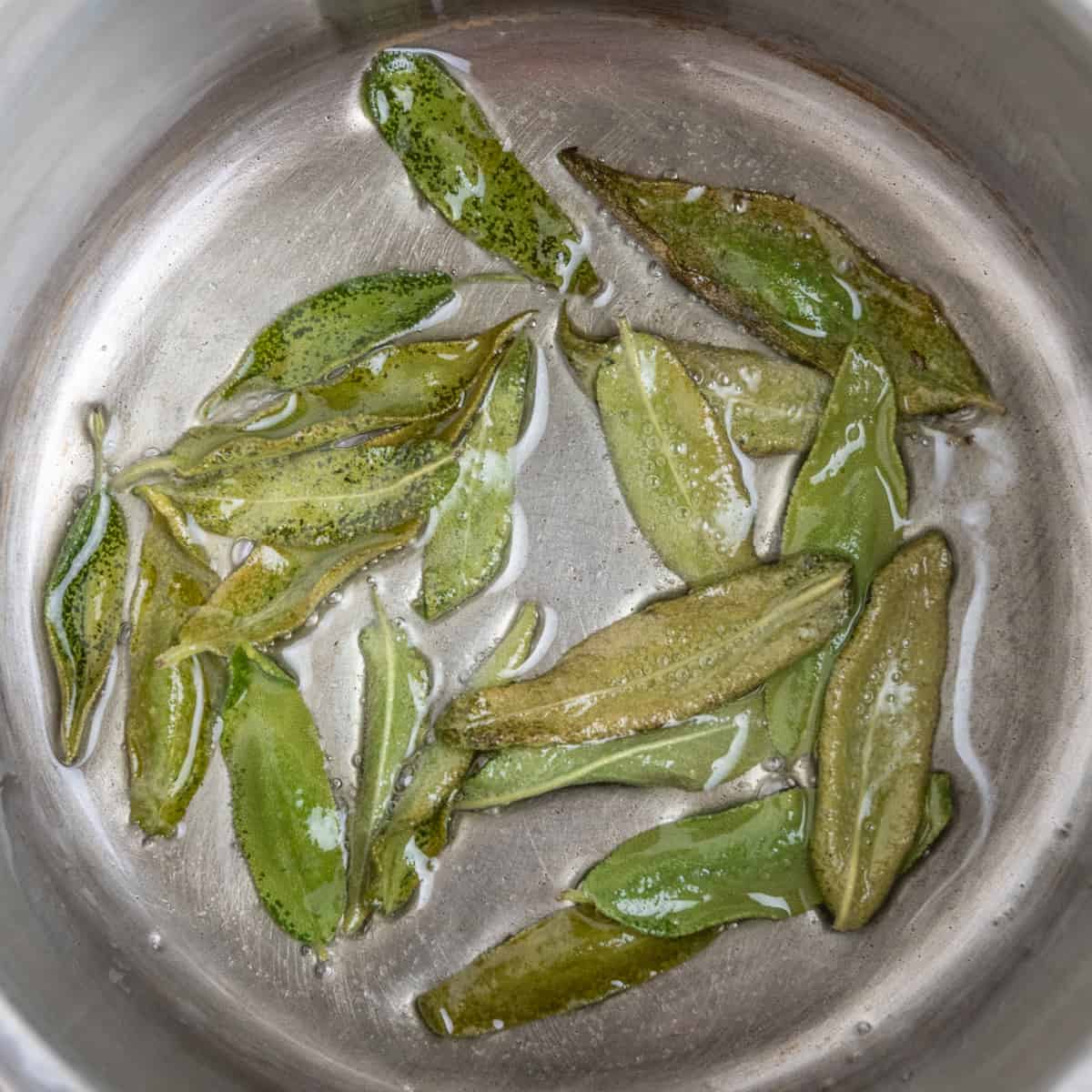
Step 10 - Heat up fresh sage with oil, and when the leaves sizzle sprinkle on a pinch of salt.
Tips and FAQ
Any white short grain rice can make a decent enough risotto. It’s grain shape is oval rather than long (like basmati or jasmine). As the grains are thicker, this rice takes a bit longer to cook.
Of the common varieties of risotto rice, Arborio is the easiest to find and a good starting point for home cooks. In Italy, the most commonly used rices are Carnaroli (for the most creamy risotto) and Vialone Nano (which cooks a bit quicker). Other good choices of risotto rice can be found in specialty shops.
Although it's not traditional, it's perfectly possible to use other types of rice than risotto rice in risotto recipes.
Brown short grain rice is a flavourful and wholesome alternative to white rice, but needs to cook up to twice as long and doesn't make the risotto as creamy. We’ve also used long white grain rice like basmati once or twice. It still makes a nice and tasty dish when you don’t have any risotto rice at hand!
Sushi rice is probably the closest match to risotto rice, so if that’s all you’ve got it is a more than acceptable choice.
There is no straightforward answer. The ratio can vary between about 2½ - 4 cups of liquid per cup of rice. A good portion of water just evaporates as steam when cooking risotto. Larger quantities often require less liquid, while smaller quantities need more.
Instead of focussing on the exact ratio, simply stop adding more liquid once the rice is done and the texture is creamy (see below).
The perfect risotto texture is just liquid enough to pour it, but thick enough to set on the plate. The risotto should also be creamy from the starches that stirring the rice releases into the liquid. The rice itself should be al dente, meaning with a little bite left but not undercooked in the core. Do your best not to overcook the rice, and keep in mind the risotto will continue to thicken after it is taken off the heat.
In most traditional risotto recipes, piping hot stock or broth is added gradually to cook the rice and incorporate flavour. In our recipe, we add vegetable stock powder (or bouillon powder) from the start, and later simply top up the liquid with boiling water. You know exactly how much flavour you’ve added, no matter how much liquid you need to cook the risotto. You won’t have any leftover stock either.

Variations and substitutions
If you’re looking for a meal with a bit more protein, why not try our Butternut and Lentil Risotto?
It’s possible to use other types of rice to make this vegan risotto, like white long grain or brown short grain rice. Just be aware that the resulting texture will differ and the required cooking time will change (also see FAQ above).
To make this recipe gluten free, use tamari in place of soy sauce.
Instead of fresh sage, you can use dried sage in the risotto itself. Use a third the amount of dried for fresh, or 1 teaspoon dried sage for each tablespoon fresh sage leaves.
You can use white wine for the deglazing step in place of the soy sauce, lemon juice and water, like in a classic Italian risotto. We usually don’t have any wine around the house to cook with, so we use these ingredients to add the same amount of flavour and acidity.
Make crispy fried sage butter instead of frying the sage in oil. Just use vegan butter in place of oil, but be careful not to burn it! As most brands of vegan butter are at least lightly salted, you can leave out extra salt.
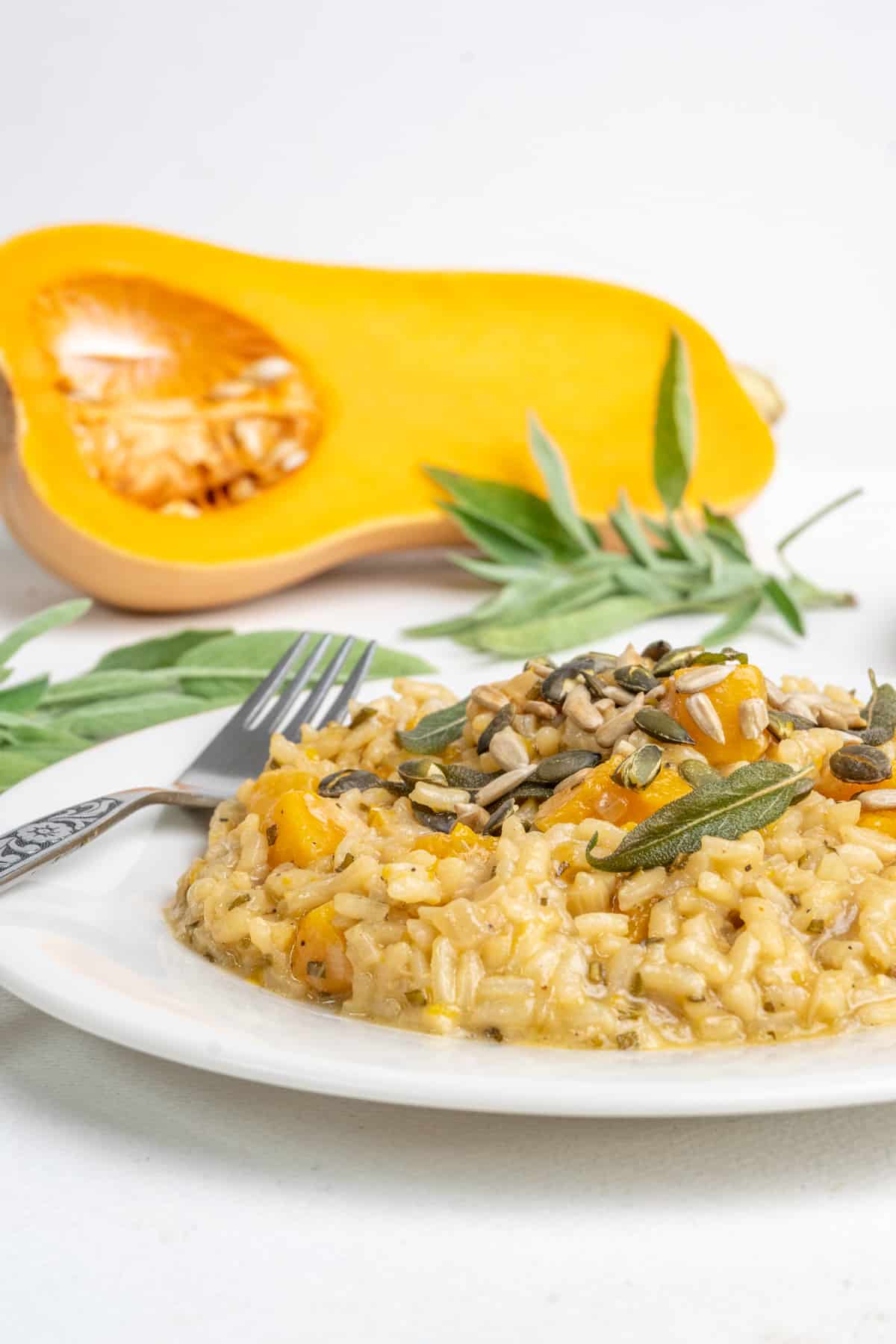
Serving
Risotto is eaten both as a starter or a main meal. As a main meal, this recipe (using 1 cup or 200g of uncooked rice) will make 3 portions. Served as a starter or light meal, it will be enough for 4.
We plate up the risotto and then add the toppings. We love the topping of toasted sunflower and pumpkin seeds for some crunch. And the crispy fried sage leaves not only look amazing, but also add extra flavour. Don't forget to also drizzle on some of the oil that the sage was fried in, as it also has a lot of sage flavour in it.
If you fancy, why not try some of our vegan parmesan to sprinkle on top?
Leftover risotto should be chilled quickly and stored in the fridge. When reheating risotto, make sure to heat the rice until steaming hot.
You can also use leftover risotto to make breaded risotto balls. Coat spoonfuls of risotto in fine breadcrumbs and fry them, or spray with oil and bake in the oven.
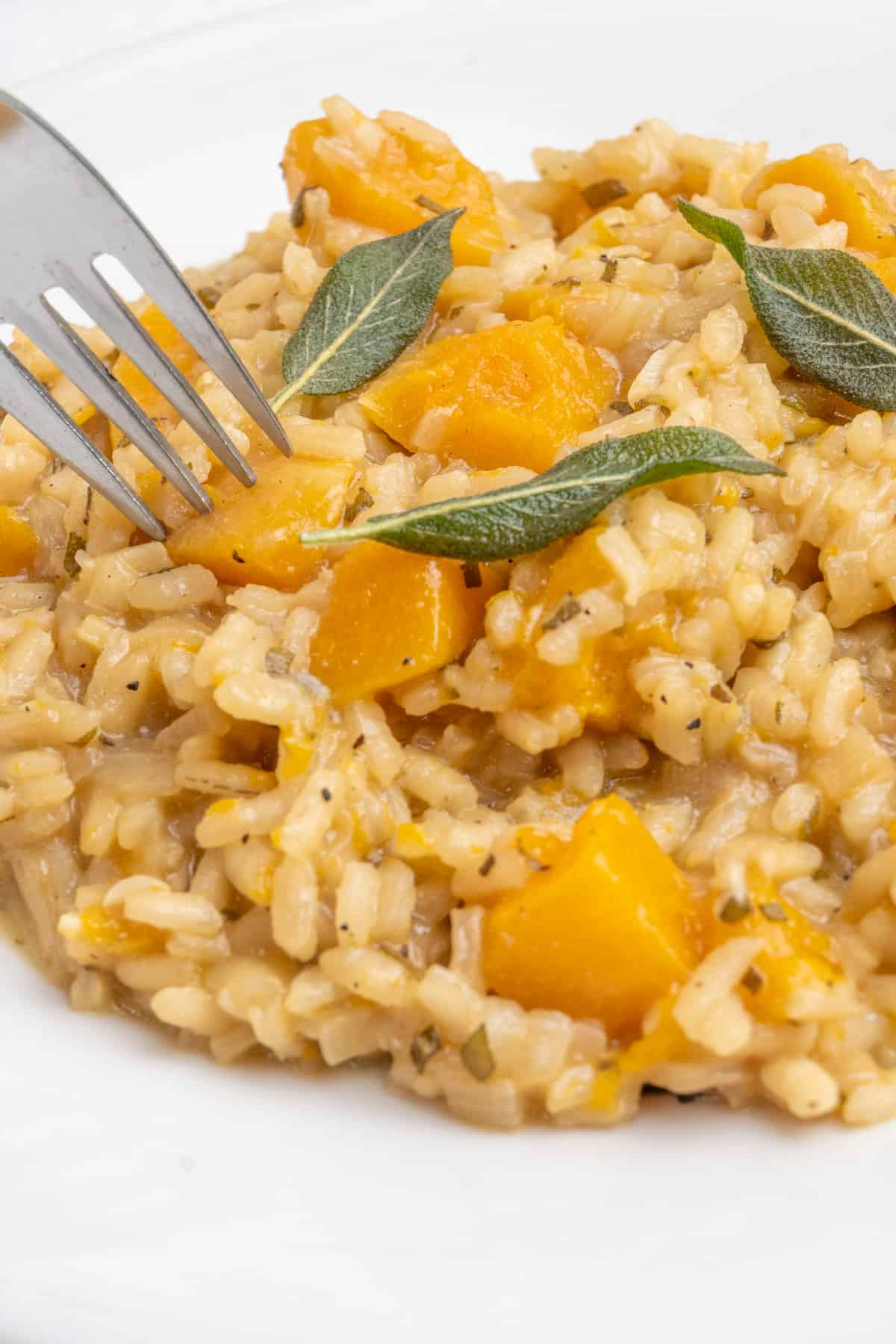
We hope you enjoy this vegan butternut squash risotto! If you have leftover squash, we can recommend these other vegan butternut squash recipes:
Lentil Risotto with Butternut Squash
📖 Recipe

Butternut Squash Risotto
Ingredients
- 3 tbsp (45 ml) olive oil extra virgin
- 1 medium onion diced
- ½ small (300 g / 2 cups) butternut squash peeled, half inch cubes
- 2 cloves garlic minced
- 2 tbsp fresh sage washed, finely chopped
- 1 tsp dried oregano
- ½ tsp black pepper ground
- 1 cup (200 g) risotto rice arborio, carnaroli, other short grain white rice
- ½ tsp garlic powder
- 2 tsp bouillon powder
- 1 tbsp (15 ml) soy sauce
- 1 tbsp (½ lime) lime juice or lemon juice / apple cider vinegar
- ¼ cup (60 ml) water (for deglazing)
- 3-4 cups (700 - 1000 ml) boiling hot water
- 2 tbsp nutritional yeast
- ¼ cup (40 g) sunflower and pumpkin seeds
Crispy fried sage:
- 1 tbsp oil
- 2 tbsp fresh sage washed and patted dry
- 1 pinch (⅛ tsp) salt
Instructions
- In a frying pan or large saucepan, heat up the olive oil on medium heat and sauté the diced onion 1-2 minutes until translucent.3 tbsp (45 ml) olive oil, 1 medium onion
- Add the cubed butternut and continue to sauté for 15 minutes on medium heat with lid on, stirring every few minutes.½ small (300 g / 2 cups) butternut squash
- Add the minced garlic, chopped fresh sage, oregano and black pepper. Stir and sauté for another 1-2 minutes.2 cloves garlic, 2 tbsp fresh sage, 1 tsp dried oregano, ½ tsp black pepper
- Add the risotto rice and fry it for 1 minute while stirring to coat the rice grains with oil.1 cup (200 g) risotto rice
- Briefly stir in the garlic powder and bouillon powder, then deglaze by adding the soy sauce, lime juice (or lemon or vinegar) and ¼ cup of water. Stir and cook on medium heat for 2-3 minutes, until the liquid is completely absorbed.½ tsp garlic powder, 2 tsp bouillon powder, 1 tbsp (15 ml) soy sauce, 1 tbsp (½ lime) lime juice, ¼ cup (60 ml) water
- Add enough boiling hot water to just cover the rice (about 1 cup), and stir.3-4 cups (700 - 1000 ml) boiling hot water
- With the lid on, simmer on medium heat for 20-25 minutes. Every few minutes, stir well and top up with boiling water to keep the rice covered with liquid. (see notes)TIP: Keep a saucepan of water just simmering on low heat on the hob while the risotto is cooking, so you always have boiling hot water to add to the pan.
- When the rice is al dente, meaning it is cooked but still has a little bite to it, take the risotto off the heat and stir in nutritional yeast. Adjust the liquid by adding hot water if needed, to get a creamy consistency. The perfect risotto consistency is smooth creamy and slightly thick, but just about pourable with no pools of liquid forming. However, the risotto will continue to absorb and thicken for a while even after taking it off the heat. Keep covered with a lid until serving.2 tbsp nutritional yeast
Serving
- Toast the sunflower and pumpkin seeds in a small saucepan or skillet on medium heat, until beginning to brown. Stir or toss frequently to keep them from burning.¼ cup (40 g) sunflower and pumpkin seeds
- For the crispy sage oil, place whole fresh sage leaves (washed and patted dry) and oil in a small saucepan and heat up over medium heat.When the leaves start to sizzle, sprinkle in the salt and stir briefly. Fry for another 15-30 seconds, then take the pan off the heat.1 tbsp oil, 2 tbsp fresh sage, 1 pinch (⅛ tsp) salt
- On the plate, top with sage oil and crispy sage leaves. Serve with salt and pepper on the table, and optional extra nutritional yeast or vegan parmesan for sprinkling on.
Notes
How much hot water will I need?
The amount of water needed is not linear to the amount of risotto you make. While more rice will of course absorb more water during cooking, how much water is lost to evaporation is mainly depending on the pan size and how much of the time the pan is covered. The total amount of water can therefore vary, and cooking smaller amounts of risotto will require proportionally more water than larger quantities. The minimum amount of water needed is about 2.5 cups of water per 1 cup of rice (600 ml per 200 g rice), but can be as much as 4 cups per 1 cup of rice (1L per 200 g).
Why are you adding boiling water instead of stock?
In traditional risotto, stock or broth is gradually added from a simmering pan on the hob, to incorporate flavour into the rice.Instead, we add stock powder to the rice before adding any liquids, and just add boiling water later. This way, there is no leftover stock once the risotto is done. Plus, the flavour is always the same, no matter how much liquid you add during cooking (see note above).
Nutrition
This information is calculated per serving and is an estimate only.



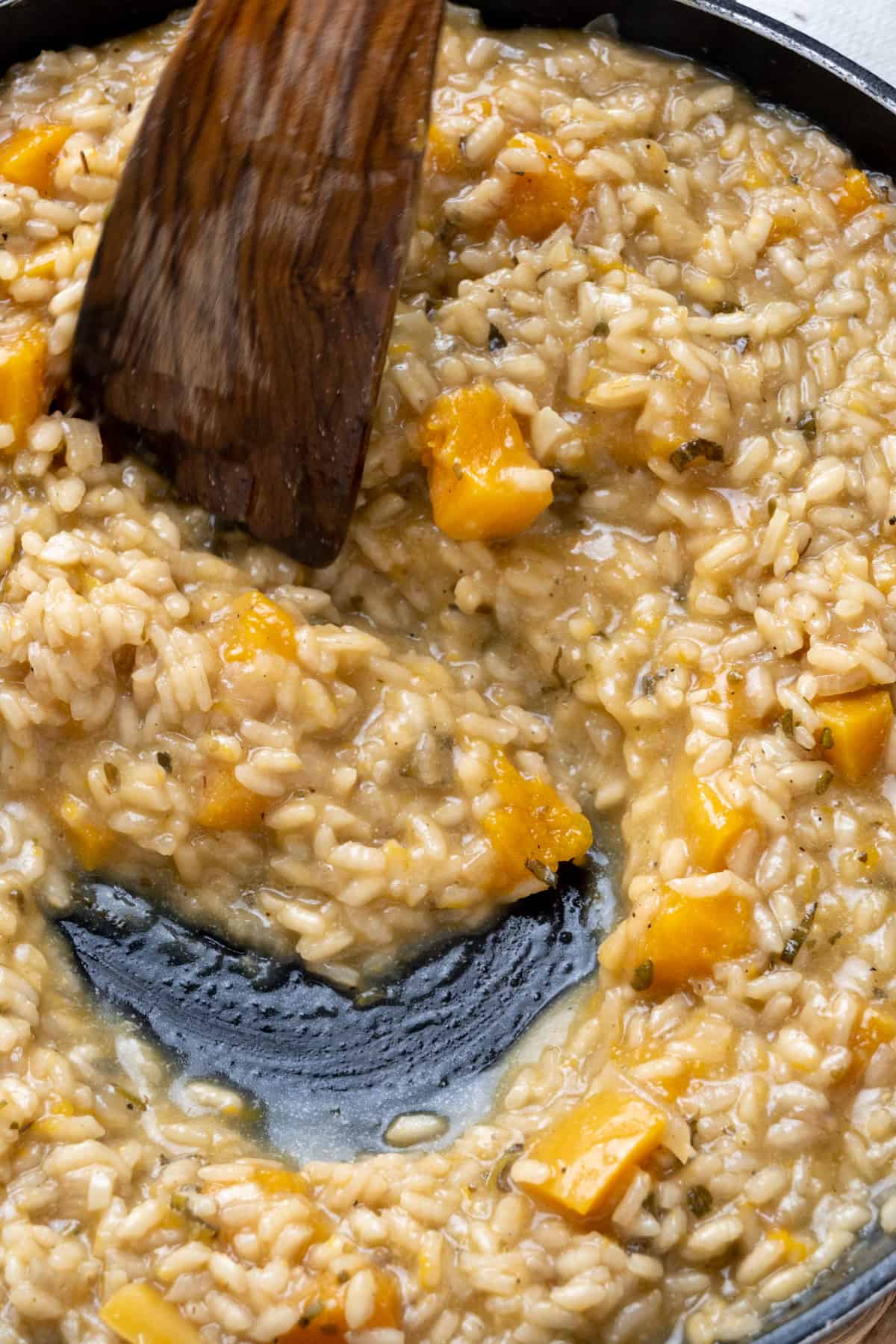
Anna says
You can never go wrong with this recipe. It is very accurate and the outcome is perfect!
Butternut squash risotto and bell peppers risotto are my favorites!
Thank you Sophie & Paul